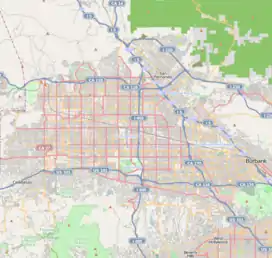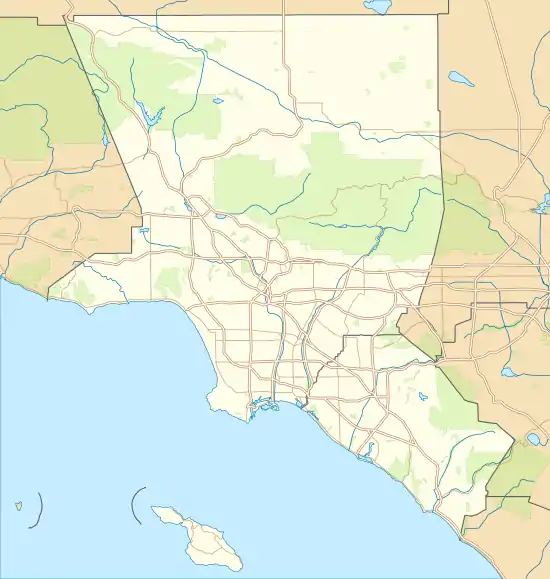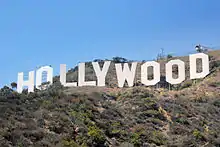Laurel Canyon, Los Angeles
Laurel Canyon is a mountainous neighborhood/canyon located in the Hollywood Hills region of the Santa Monica Mountains, in the Hollywood Hills West district of Los Angeles, California.
Laurel Canyon, Los Angeles | |
|---|---|
 Laurel Canyon, Los Angeles Location within Los Angeles and San Fernando Valley  Laurel Canyon, Los Angeles Laurel Canyon, Los Angeles (the Los Angeles metropolitan area) | |
| Coordinates: 34.117275°N 118.375281°W | |
| Country | |
| State | |
| County | |
| City | |
| Elevation | 264 m (866 ft) |
| Time zone | UTC-8 (PST) |
| • Summer (DST) | UTC-7 (PDT) |
Location
Laurel Canyon is focused on its central thoroughfare, Laurel Canyon Boulevard. However, unlike other nearby canyon neighborhoods, Laurel Canyon has houses lining one side of the main street most of the way up to Mulholland Drive. There are many side roads that branch off the main canyon, but most are not through streets, reinforcing the self-contained nature of the neighborhood. Some of the main side streets are Mount Olympus, Kirkwood, Wonderland Avenue, Willow Glen, and Lookout Mountain Avenue. The zip code for a portion of the neighborhood is 90046.[1]
Laurel Canyon Boulevard is an important North-South route between: West Hollywood, Hollywood, and Central Los Angeles; and Studio City and the eastern San Fernando Valley. The canyon's division between the two regions is defined by Mulholland Drive.
The Laurel Canyon neighborhood is generally bounded by West Hollywood to the west and south, Hollywood to the east, and Studio City to the north.[2]
History
Tongva Indigenous Peoples
The Laurel Canyon area was inhabited by the Tongva people, a regional tribe of the indigenous peoples of California, for thousands of years. A spring-fed stream flowed year-round providing water.
The reliable water supply attracted colonial Spanish ranchers who started grazing sheep on the hillsides in the late 18th and early 19th centuries. After the Mexican–American War and the advent of U.S. statehood for California in 1850, the area was settled by Americans interested in water rights.
Lookout Mountain
Until the twentieth century, passage up the canyon was made on foot or by mule. In 1907, an 82-mile dirt road, later named Laurel Canyon Boulevard, was built. It ran up the canyon, dividing at what is now Lookout Mountain Road; the left road went up to the summit of Lookout Mountain, and the right branch of the road went to the top of the Santa Monica Mountains and then down to the San Fernando Valley.
In 1908, the Lookout Mountain Park and Water Co. was formed to purchase 280 acres on Lookout Mountain, just west of Laurel Canyon, subdivided and marketed as mountain vacation properties. On Aug. 14, 1908, the Los Angeles Times announced that the company would build Lookout Mountain Inn at the summit of Lookout Mountain and Sunset Plaza roads, and Lookout Mountain Park, Bungalow Land at Laurel Canyon Boulevard and Lookout Mountain Avenue and Wonderland Park.[3] Two years later, the company widened the winding dirt road to the top of Lookout Mountain where they built the Lookout Mountain Inn.[4][5]
In 1912, Charles Mann, a real estate developer and Richard Shoemaker, an engineer,[6] built a trackless electric trolley bus line which ran between the Laurel Canyon Pacific Electric Shuttle stop at the foot of Laurel Canyon at Sunset Boulevard, The Laurel Canyon Pacific Electric Shuttle ran from the foot of Laurel Canyon at Sunset Boulevard to Gardner Junction at Gardner Street and Sunset Boulevard, Beverly Hills line of the Pacific Electric Railway station. (1451 N Gardner St, West Hollywood, CA 90046 [7][8] up Laurel Canyon Road from Sunset Boulevard to the Tavern at the base of Lookout Mountain Road, a road house serving visitors.
The car had two trolley poles, one to a positive overhead wire and one to a ground overhead wire, and was able to sway to either side of the street, only using power uphill. The trolley was actually a 1912 Oldsmobile with an electric motor and 10-passenger capacity.[3] The overhead wires came down and the service was replaced by Stanley Steamers about 1915. Until 1918, the trackless trolley traveled up and down Laurel Canyon to meet the half hour schedule to Los Angeles. It was insufficiently patronized and discontinued when Pacific Electric stopped running streetcars between Gardner Junction and Laurel Canyon Boulevard, and demand failed to support it.[15][16]
On October 26, 1918, a fire, fanned by strong Santa Ana winds, burned about 200 acres and totally destroyed Lookout Mountain Inn at the summit of Lookout Mountain Avenue and Sunset Plaza Drive.[17][18][15][16][19][20][21][16][22] Another major fire occurred in July 1959, destroying some 38 homes.[23]
As the roads were improved, access was possible by automobile.[24][25][26][27][28][29]
Now a vacant lot, the corner of Lookout Mountain Avenue and Laurel Canyon Blvd (2401 Laurel Canyon Blvd)[30] is where the Tavern, a famous 1915 "Log Cabin" mansion stood, with its 80-foot living room, floor to ceiling fireplace, bowling alley and indoor sunken swimming pool.[31] It was once occupied by silent film star Tom Mix[32] but spent years on the rental market. In 1968 it was rented by Frank Zappa who turned it into a recording studio and celebrity hangout.[33][34] However, Zappa moved out after six months. The house burned to the ground on Halloween 1981.
Directly across the street, at 2400 Laurel Canyon Blvd., is site of the home, long-gone, that magician Harry Houdini may have rented around 1919. It was originally the Walker estate.[35][36]
Counterculture of the 1960s & 70s
Laurel Canyon became a nexus of counterculture activity and attitudes in the mid-late 1960s and early 1970s, becoming famous as home to many of L.A.'s rock musicians, such as Cass Elliot; Joni Mitchell; Frank Zappa; Jim Morrison of The Doors; Carole King; The Byrds; Buffalo Springfield; Canned Heat; John Mayall; members of the band The Eagles; the band Love; Neil Young; Brian Wilson of The Beach Boys as well as James Taylor, Jackson Browne, Bonnie Raitt, Linda Ronstadt, Harry Nilsson;[37] and Micky Dolenz & Peter Tork of The Monkees. Cass Elliot's home was considered one of Laurel Canyon's biggest party houses with all-night, drug-fueled sleepovers, well attended by the hippest musicians and movie stars of the era.[38]
John Phillips of the Mamas & the Papas took inspiration from their home in Laurel Canyon for the song "Twelve Thirty (Young Girls Are Coming to the Canyon)”, released in 1967. The following year, blues artist John Mayall recorded and released the album Blues from Laurel Canyon based on his experiences during a vacation that he spent in the Canyon.
Perhaps most famously, the area and its denizens served as inspiration for Joni Mitchell's third album, Ladies of the Canyon, released in 1970. The house she lived in was immortalized in the Crosby, Stills, and Nash song, "Our House" (1970), written by her then-lover Graham Nash. The group is reputed to have first sung together in Mitchell's living room.[39]
Legendary rock photographer Henry Diltz was also a resident and used the scenic Canyon backdrop for many of his historic photos of rock musicians casually socializing. Several of his photos became iconic representations of the 1960s and 1970s' West Coast music scene; others became famous album sleeve covers, such as CSN's debut album, Crosby, Stills & Nash (photographed in nearby West Hollywood).
Later years
Musician Josh Tillman has said that his output under the moniker Father John Misty was partly inspired by a relocation to and personal reinvention in Laurel Canyon. The song "I Went to the Store One Day," from his 2015 album I Love You, Honeybear, recounts the story of how Tillman met his wife, Emma, in the parking lot of the Laurel Canyon Country Store.[40][41]
Wonderland murders
On July 1, 1981, three members and one associate of the Wonderland Gang, so-called because they were based at 8763 Wonderland Avenue, died in the Wonderland murders (also known as the "Four on the Floor murders" or the "Laurel Canyon murders"). Salon reports: "The massacre took place just down the street from what was then the home of Jerry Brown, who was California’s governor at the time. And 8763 Wonderland Ave. itself is said to have been inhabited at one time by Paul Revere and the Raiders."[42]
See also
References
- "ZIP Code™ Lookup - USPS". tools.usps.com.
- "Mary Mallory / Hollywood Heights: Lookout Mountain Inn Promotes Real Estate". 6 October 2014. Retrieved 18 July 2018.
- https://cdnc.ucr.edu/cgi-bin/cdnc?a=d&d=LAH19100306.2.133.57 Los Angeles Herald, Volume 37, Number 156, 6 March 1910 "Mrs. F. J. Talamantes, accompanied by her daughters, Mrs. M. D. O'Farrell and Miss Fay Talamantes, left yesterday for a two weeks' stay at Bungalow Inn, in Laurel canyon"
- "Water and Power Associates". waterandpower.org. Retrieved 18 July 2018.
- "Google Maps". Google Maps.
- "Map" (PDF). www.pacificelectric.org.
- "Photo" (JPG). jpg2.lapl.org.
- "Index of/00018". jpg4.lapl.org. Retrieved 18 July 2018.
- de:Datei:Trackless Trolley 00018878.jpg
- "Photo" (JPG). www.dkse.net.
- "Photo" (JPG). www.dkse.net.
- "Photo" (JPG). www.dkse.net.
- "SkyscraperPage Forum - View Single Post - noirish Los Angeles". forum.skyscraperpage.com. Retrieved 18 July 2018.
- "CityDig: Looking Back at the Lookout Mountain Inn Los Angeles Magazine". 23 October 2013. Retrieved 18 July 2018.
- "Laurel Canyon Suite: Gods, Myths, and Fires". 19 April 2017. Retrieved 18 July 2018.
- "SkyscraperPage Forum - View Single Post - noirish Los Angeles". forum.skyscraperpage.com. Retrieved 18 July 2018.
- "8626 Skyline Drive - John Bertram in Laurel Canyon". 8 October 2014. Retrieved 18 July 2018.
- "Laurel Canyon". Pinterest. Retrieved 18 July 2018.
- "Hollywood Historic Photos". hollywoodhistoricphotos.com. Retrieved 18 July 2018.
- "Laurel Canyon's Flammable History - Canyon News". 27 August 2010. Retrieved 18 July 2018.
- Cecilia Rasmussen (May 11, 2007). "Looking back: Some of L.A.'s worst blazes". Archived from the original on February 3, 2020."Detail". martinturnbull.com.
- "Detail". martinturnbull.com.
- "Laurel Canyon". 12 October 2016. Retrieved 18 July 2018.
- "Laurel Canyon Association: 20th Century Canyon History". Web.archive.org. Archived from the original on 2004-06-12. Retrieved 2018-07-18.
- "Dave McGowan on the Hippie Era and Stranger than Fiction Laurel Canyon Rock Scene - FarOutRadio.com". faroutradio.com. Retrieved 18 July 2018.
- "8917 Appian Way - Spanish Home in Sunset Strip West". 21 January 2015. Retrieved 18 July 2018.
- "Laurel Canyon Neighborhood Posts - Brian Ades Legacies of L.A." Brian Ades Legacies of L.A. Retrieved 18 July 2018.
- Brown, August (2 August 2007). "Where the rockers let their hair down". Retrieved 18 July 2018 – via LA Times.
- "Archived copy". Archived from the original on 2011-11-17. Retrieved 2016-05-03.CS1 maint: archived copy as title (link)
- "Archived copy". Archived from the original on 2013-08-26. Retrieved 2016-05-03.CS1 maint: archived copy as title (link)
- Dowd, Vincent (28 September 2011). "Frank Zappa: the clean-living hellraiser". BBC News. Retrieved 6 September 2014. Interview with Pauline Butcher, Zappa's live-in secretary.
- "The Rock and Roll Treehouse". www.jackboulware.com. Retrieved 18 July 2018.
- "Inside the Laurel Canyon Houdini Estate". www.wildabouthoudini.com. Retrieved 18 July 2018.
- "Laurel Canyon Part 4". 4 January 2010. Retrieved 18 July 2018.
- Stevens, Jenny (February 17, 2020). "'I Was a Bad Influence on the Beatles': James Taylor on Lennon, Love and Recovery". via Pocket. The Guardian. Retrieved 12 April 2020.
- Fiegel, Eddi (28 September 2005). Dream A Little Dream Of Me. Chiacgo Review Press.
- Sheila Weller, Girls Like Us: Carole King, Joni Mitchell, Carly Simon—And the Journey of a Generation, Atria Books, 2008, ISBN 0743491475.
- Weiner, Jonah (19 February 2015). "The Gospel of Father John Misty". Rolling Stone. Retrieved 18 July 2018.
- Fennessey, Sean (6 February 2015). "The Third Revelation of Father John Misty". Grantland. Retrieved 18 July 2018.
- Lemons, Stephen (June 9, 2000). "Return to Wonderland". Salon.
Further reading
- Michael Walker, Laurel Canyon: The Inside Story of Rock ’n’ Roll’s Legendary Neighborhood, Farrar Straus and Giroux (16 May 2006), hardcover, 277 pages, ISBN 0-571-21149-6 trade paperback (May 1, 2007); ISBN 0-86547-966-6.
- Barney Hoskyns, Hotel California: Singer-Songwriters and Cocaine Cowboys in the LA Canyons, 1967–1976, Harper Perennial (2006), Paperback, 316 pages, ISBN 0-00-717705-4
- Harvey Kubernik, Scott Calamar, Diltz, Henry, Lou Adler, Canyon of Dreams: The Magic and the Music of Laurel Canyon (Sterling Publishing, 2009), 384 pages, ISBN 978-1-4027-6589-6. Excerpts available at Google Books.
- David McGowan, Weird Scenes Inside the Canyon: Laurel Canyon, Covert Ops & the Dark Heart of the Hippie Dream, Headpress (18. April 2014), Paperback, 320 Pages, ISBN 978-1909394124
External links
- www.laurelcanyon.org—website for the Laurel Canyon Association, which contains an extensive history edited by Rick Seireeni
- "Music and Mayhem in 'Laurel Canyon'", from NPR.org broadcast September 6, 2006
.jpg.webp)

